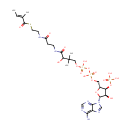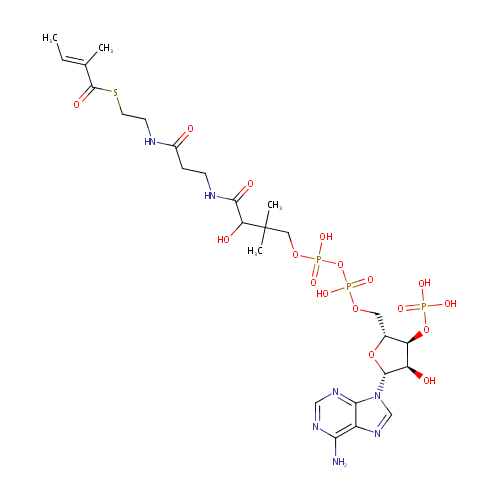|
Record Information |
|---|
| Version |
1.0 |
|---|
| Update Date |
1/22/2018 11:54:54 AM |
|---|
|
Metabolite ID | PAMDB000433 |
|---|
|
Identification |
|---|
| Name: |
Tiglyl-CoA |
|---|
| Description: | Tiglyl-CoA is a metabolite in the degradation of isoleucine to propionic acid pathway. It is a substrate of enoyl-CoA hydratase-isomerase [EC:4.2.1.17] and converted to (2S,3S)-3-Hydroxy-2-methylbutanoyl-CoA. |
|---|
|
Structure |
|
|---|
| Synonyms: | - (E)-2-Methylcrotonoyl-CoA
- (E)-2-Methylcrotonoyl-Coenzyme A
- 2-Methylbut-2-enoyl-CoA
- 2-Methylbut-2-enoyl-Coenzyme A
- 2-Methylcrotanoyl-CoA
- 2-Methylcrotanoyl-Coenzyme A
- 2-Methylcrotonoyl-CoA
- 2-Methylcrotonoyl-Coenzyme A
- 2-Methylcrotonyl-CoA
- 2-Methylcrotonyl-Coenzyme A
- Methylcrotonoyl-CoA
- Methylcrotonoyl-Coenzyme A
- Methylcrotonyl-CoA
- Methylcrotonyl-Coenzyme A
- Tigloyl-CoA
- Tigloyl-Coenzyme A
- Tiglyl-CoA
- Tiglyl-coenzyme A
- Trans-2-Methylbut-2-enoyl-CoA
- Trans-2-Methylbut-2-enoyl-Coenzyme A
|
|---|
|
Chemical Formula: |
C26H42N7O17P3S |
|---|
| Average Molecular Weight: |
849.635 |
|---|
| Monoisotopic Molecular
Weight: |
849.157073179 |
|---|
| InChI Key: |
PMWATMXOQQZNBX-APMDNKNFSA-N |
|---|
| InChI: | InChI=1S/C26H42N7O17P3S/c1-5-14(2)25(38)54-9-8-28-16(34)6-7-29-23(37)20(36)26(3,4)11-47-53(44,45)50-52(42,43)46-10-15-19(49-51(39,40)41)18(35)24(48-15)33-13-32-17-21(27)30-12-31-22(17)33/h5,12-13,15,18-20,24,35-36H,6-11H2,1-4H3,(H,28,34)(H,29,37)(H,42,43)(H,44,45)(H2,27,30,31)(H2,39,40,41)/b14-5+/t15-,18-,19-,20?,24-/m1/s1 |
|---|
| CAS
number: |
Not Available |
|---|
| IUPAC Name: | {[(2R,3S,4R,5R)-5-(6-amino-9H-purin-9-yl)-4-hydroxy-2-({[hydroxy({hydroxy[3-hydroxy-2,2-dimethyl-3-({2-[(2-{[(2E)-2-methylbut-2-enoyl]sulfanyl}ethyl)carbamoyl]ethyl}carbamoyl)propoxy]phosphoryl}oxy)phosphoryl]oxy}methyl)oxolan-3-yl]oxy}phosphonic acid |
|---|
|
Traditional IUPAC Name: |
[(2R,3S,4R,5R)-5-(6-aminopurin-9-yl)-4-hydroxy-2-[({hydroxy[hydroxy(3-hydroxy-2,2-dimethyl-3-({2-[(2-{[(2E)-2-methylbut-2-enoyl]sulfanyl}ethyl)carbamoyl]ethyl}carbamoyl)propoxy)phosphoryl]oxyphosphoryl}oxy)methyl]oxolan-3-yl]oxyphosphonic acid |
|---|
| SMILES: | C\C=C(/C)C(=O)SCCNC(=O)CCNC(=O)C(O)C(C)(C)COP(O)(=O)OP(O)(=O)OC[C@H]1O[C@H]([C@H](O)[C@@H]1OP(O)(O)=O)N1C=NC2=C(N)N=CN=C12 |
|---|
|
Chemical Taxonomy |
|---|
|
Taxonomy Description | This compound belongs to the class of organic compounds known as acyl coas. These are organic compounds containing a coenzyme A substructure linked to an acyl chain. |
|---|
|
Kingdom |
Organic compounds |
|---|
| Super Class | Lipids and lipid-like molecules |
|---|
|
Class |
Fatty Acyls |
|---|
| Sub Class | Fatty acyl thioesters |
|---|
|
Direct Parent |
Acyl CoAs |
|---|
| Alternative Parents |
|
|---|
| Substituents |
- Coenzyme a or derivatives
- Purine ribonucleoside diphosphate
- Purine ribonucleoside 3',5'-bisphosphate
- N-glycosyl compound
- Glycosyl compound
- Organic pyrophosphate
- Monosaccharide phosphate
- 6-aminopurine
- Purine
- Imidazopyrimidine
- Monoalkyl phosphate
- Aminopyrimidine
- Imidolactam
- Alkyl phosphate
- Pyrimidine
- Primary aromatic amine
- Phosphoric acid ester
- Organic phosphoric acid derivative
- Organic phosphate
- N-substituted imidazole
- Monosaccharide
- Saccharide
- Heteroaromatic compound
- Oxolane
- Imidazole
- Azole
- Thiocarboxylic acid ester
- Secondary alcohol
- Oxacycle
- Azacycle
- Organoheterocyclic compound
- Organic 1,3-dipolar compound
- Propargyl-type 1,3-dipolar organic compound
- Sulfenyl compound
- Thioether
- Thiocarboxylic acid or derivatives
- Carboxylic acid derivative
- Carboximidic acid derivative
- Carboximidic acid
- Hydrocarbon derivative
- Primary amine
- Organosulfur compound
- Organooxygen compound
- Organonitrogen compound
- Amine
- Alcohol
- Aromatic heteropolycyclic compound
|
|---|
| Molecular Framework |
Aromatic heteropolycyclic compounds |
|---|
| External Descriptors |
Not Available |
|---|
|
Physical Properties |
|---|
| State: |
Solid |
|---|
| Charge: | -4 |
|---|
|
Melting point: |
Not Available |
|---|
| Experimental Properties: |
|
|---|
| Predicted Properties |
|
|---|
|
Biological Properties |
|---|
| Cellular Locations: |
Cytoplasm |
|---|
| Reactions: | |
|---|
|
Pathways: |
- Valine, leucine and isoleucine degradation pae00280
|
|---|
|
Spectra |
|---|
| Spectra: |
|
|---|
|
References |
|---|
| References: |
- Duran M, Bruinvis L, Ketting D, Kamerling JP, Wadman SK, Schutgens RB: The identification of (E)-2-methylglutaconic acid, a new isoleucine metabolite, in the urine of patients with beta-ketothiolase deficiency, propionic acidaemia and methylmalonic acidaemia. Biomed Mass Spectrom. 1982 Jan;9(1):1-5. Pubmed: 7059658
- Kanehisa, M., Goto, S., Sato, Y., Furumichi, M., Tanabe, M. (2012). "KEGG for integration and interpretation of large-scale molecular data sets." Nucleic Acids Res 40:D109-D114. Pubmed: 22080510
|
|---|
| Synthesis Reference: |
Not Available |
|---|
| Material Safety Data Sheet (MSDS) |
Not Available |
|---|
|
Links |
|---|
| External Links: |
|
|---|


